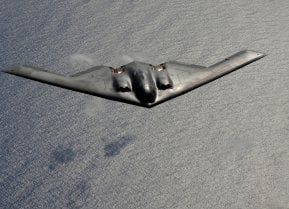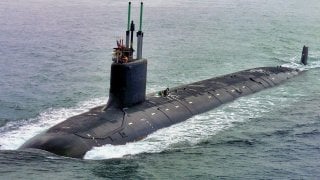Block V Virginia-Class Submarine: What the U.S. Navy Needs Right Now
The Virginia-class Block V are arguably the boats that the U.S. Navy needs for now and could remain in service for decades to come, but it appears that they simply can't be built fast enough.
Virginia-class Block V Submarine - The United States Navy's Virginia-class submarines – also known as the SSN-774 class – of nuclear-powered cruise missile fast-attack submarines were developed in the 1990s to incorporate the latest in stealth, intelligence gathering, and weapons systems. The boats, which will replace the U.S. Navy's older Los Angeles-class submarines, were further designed to conduct a broad spectrum of open-ocean and littoral missions, including anti-submarine warfare (ASW) and intelligence-gathering operations.
Since entering service in 2004, the Virginia-class subs have been able to support five of the U.S. Navy's six maritime strategy core capabilities including sea control, power projection, forward presence, maritime security, and deterrence.
The SSNs have a fly-by-wire ship control system that also provides improved shallow-water ship handling, while subs were also designed to deploy special operator forces including Navy SEALS. A reconfigurable torpedo room can accommodate a large number of SOFs and all their equipment for prolonged deployments and future off-board payloads.
The U.S. Navy has called for a total of 66 Virginia-class subs to be constructed, and 22 are now active, while an additional 10 are now under construction.
The U.S. Navy is now completing the Block IV submarines and is now looking forward to the enhancements provided with Block V.
Virginia-Class Block V Submarine: Enter the New Boat on the Block
All of the ten planned Virginia-class Block V submarines will also be equipped with acoustic superiority upgrades, which the U.S. Navy has seen as crucial to maintaining design superiority over near-peer adversaries, notably Russia's and China's submarines.
The overall design will differ from the Block IV boats by approximately 20 percent, according to a February 2022 Congressional Research Service (CRS) report.
"Most Virginia-class boats procured in FY2019 and subsequent years are to be built with the Virginia Payload Module (VPM), an additional, 84-foot-long, mid-body section equipped with four large-diameter, vertical launch tubes for storing and launching additional Tomahawk missiles or other payloads. When procured at a rate of two boats per year, VPM-equipped Virginia-class SSNs have an estimated procurement cost of about $3.45 billion per boat,” the CRS report noted.
The Block V submarines are larger than the previous versions, with the length increased from 377 feet to 460 feet, and with greater displacement from 7,800 tons to 10,200 tons. As a result, the Block V versions of the Virginia-class are the second-largest U.S. submarines produced behind only the Ohio-class.
This added an 83-foot section to increase the number of missile launch tubes from twelve to forty, which in essence could triple the capacity of short targets for each boat. As part of the VPM, this extended mid-body section can be used to store and fire additional Tomahawk cruise missiles and other payloads; including large-diameter unmanned underwater vehicles (UUVs).
The VPM will give the Virginia-class, which is already a heavily armed nuclear-powered fast-attack submarine, a massive increase in capabilities. The Block V will greatly increase the number of missiles that can be carried and essentially make it a cruise missile submarine (SSGN). Each VPM has the capacity for 40 cruise missiles. The VPM also increased the number of torpedo-sized weapons carried by each submarine from about 37 to about sixty-five, an increase of 76 percent.
Additionally, with advancements in hypersonic missile technology, the Virginia-class will be equipped with a larger launcher that will be well-suited to host such weapons once they are deployable. The boats can also host the new version of the anti-ship Maritime Strike Tomahawk.
According to H I Sutton, writing for Naval News, the Block Vs are expected to receive the Large Vertical Array (LVA) flank sonars – which would be in addition to the six ultra-modern Light Weight Wide Aperture Arrays (LWWAA) that are located along the submarine's side.
While this has greatly increased the estimated recurring unit procurement costs of the Block V boats, the numerous improvements and upgrades will make these the most heavily armed attack submarines ever in the U.S. Navy and could ensure that they're able to serve well into the 2070s and beyond.
Coming Soon – Maybe Not
The biggest threat to the Virginia-class Block V boats may not be from an adversary such as Russia or China. Rather, it could be the state of America's submarine industrial base, which may lack the capacity to build the submarines as quickly as the U.S. Navy needs them.
In June 2023, the Government Accountability Office (GOA) warned that the Navy's shipbuilders lack the sufficient workforce to complete the Virginia-class program while also building Columbia-class ballistic missile submarines. Due to problems with staffing and work efficiency estimates, each Block V boat could take an average of two years longer to build than previously reported.
The Virginia-class Block V are arguably the boats that the U.S. Navy needs for now and could remain in service for decades to come, but it appears that they simply can't be built fast enough.
Author Experience and Expertise
Peter Suciu is a Michigan-based writer. He has contributed to more than four dozen magazines, newspapers, and websites with over 3,200 published pieces over a twenty-year career in journalism. He regularly writes about military hardware, firearms history, cybersecurity, politics, and international affairs. Peter is also a Contributing Writer for Forbes and Clearance Jobs. You can follow him on Twitter: @PeterSuciu.


